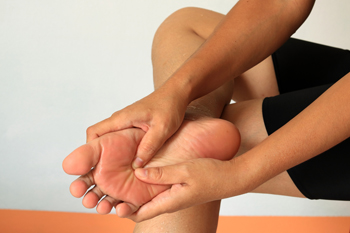Numbing Sensation in the Feet and Toes
Monday, 06 July 2020 00:00 Experiencing a numbing sensation in the feet and toes can be an indicator of Peripheral Artery Disease, also known as PAD. This condition typically develops due to a build-up of fatty deposits on the walls of the arteries. The numbing sensation that is often associated with this condition can be incredibly dangerous, as it can prevent patients from feeling or recognizing injuries to the feet. Scrapes and wounds that are left undetected may lead to an infection. Along with experiencing a numbness in the lower extremity regions, patients with PAD have also noted experiencing symptoms such as coldness and discoloration of the legs and feet. In order to safely treat PAD, please seek the professional care of a podiatrist.
Experiencing a numbing sensation in the feet and toes can be an indicator of Peripheral Artery Disease, also known as PAD. This condition typically develops due to a build-up of fatty deposits on the walls of the arteries. The numbing sensation that is often associated with this condition can be incredibly dangerous, as it can prevent patients from feeling or recognizing injuries to the feet. Scrapes and wounds that are left undetected may lead to an infection. Along with experiencing a numbness in the lower extremity regions, patients with PAD have also noted experiencing symptoms such as coldness and discoloration of the legs and feet. In order to safely treat PAD, please seek the professional care of a podiatrist.
Peripheral artery disease can pose a serious risk to your health. It can increase the risk of stroke and heart attack. If you have symptoms of peripheral artery disease, consult with one of our podiatrists from Family Foot Care. Our doctors will assess your condition and provide you with quality foot and ankle treatment.
Peripheral artery disease (PAD) is when arteries are constricted due to plaque (fatty deposits) build-up. This results in less blood flow to the legs and other extremities. The main cause of PAD is atherosclerosis, in which plaque builds up in the arteries.
Symptoms
Symptoms of PAD include:
- Claudication (leg pain from walking)
- Numbness in legs
- Decrease in growth of leg hair and toenails
- Paleness of the skin
- Erectile dysfunction
- Sores and wounds on legs and feet that won’t heal
- Coldness in one leg
It is important to note that a majority of individuals never show any symptoms of PAD.
Diagnosis
While PAD occurs in the legs and arteries, Podiatrists can diagnose PAD. Podiatrists utilize a test called an ankle-brachial index (ABI). An ABI test compares blood pressure in your arm to you ankle to see if any abnormality occurs. Ultrasound and imaging devices may also be used.
Treatment
Fortunately, lifestyle changes such as maintaining a healthy diet, exercising, managing cholesterol and blood sugar levels, and quitting smoking, can all treat PAD. Medications that prevent clots from occurring can be prescribed. Finally, in some cases, surgery may be recommended.
If you have any questions, please feel free to contact our offices located in Valatie and Albany, NY . We offer the newest diagnostic and treatment technologies for all your foot care needs.
Read more about Peripheral Artery Disease


